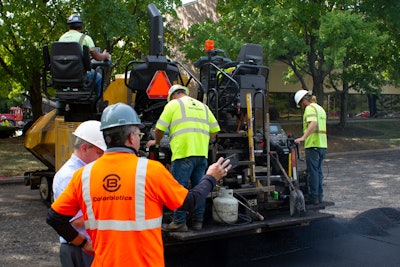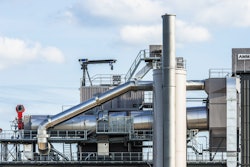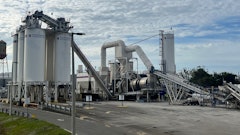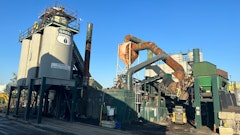
The world is changing at an ever-increasing rate. Every major industry in the country is experiencing phases of unpredictability as our way-of-life and our way-of-doing business repeatedly fluctuate. One of the fulcrum points of these shifts centers on the changes to our climate, its impact on our infrastructure, and the policy and regulatory responses that set new goals (or place new demands, depending on how you look at it). As industry producers and contractors look for ways to become more efficient and sustainable, they will need new innovations to meet the most ambitious timelines.
Fruits of the Land
Out in the farmlands of Iowa they grow a variety of crops, especially the humble, yet multifaceted soybean. They are grown in large quantities. According to the United States Department of Agriculture, in 2020 the state produced a yield of over 500 million bushels of soybeans, which ballooned to over 620 million bushels in 2021, coming in only second place to Illinois in overall production nationally. It is the perfect place to take some of that abundantly produced crop and see what new applications it can be used for.
Because of this, that a solid relationship formed between a group of researchers at Iowa State University and the team from Colorbiotics. "We're local, and we've existed as a company since the 1980s," Austin Hohmann, Product Manager at Colorbiotics said. "We've been around for a long time in other marketplaces, and we're part of a larger organization as well. So, from our standpoint, it just made sense to look at diversification."
The development of soy use diversification is encouraged by the American Soybean Association (ASA). ASA is a 100-year-old governing body that has 26 affiliated state soybean associations representing 30 soybean-producing states and more than 500,000 U.S. soybean farmers. One of their focal points of the is policy development and implementation. According to the group's 2022 directory of resolutions, one of their primary goals is supporting "soybean composition that focuses on the enhancement of industrial applications," amongst a wider range of goals associated with expanding the crops use and application.
This made sense as a pathway for soybean diversification for Colorbiotics, but it was also an alignment of other factors that led to a fruitful partnership with Iowa State University. “It was a mutual process. We started talking and it became apparent to all of us that we were headed in a good direction,” said Kent Rotert, vice president at Colorbiotics. “We offered value that they did not have and vice versa. We looked at our shared values and saw that both of us could support one another within the process and built a relationship from there.”
Farmlands-to-Freeways
Colorbiotics sees itself as a scientifically innovative company at the forefront of sustainable innovations, and the soybean is the perfect medium for their goals. The company has more than twenty-five years’ experience in products like rubberized mulch, coatings, colorants for recreational parks, artificial athletic fields, and now, with their newly approved USDA BioPreferred soybean products, they have multiple sustainable breakthroughs in asphalt rejuvenation technology:
- InvigorateTM Additive (100% biobased)
- InvigorateTM Topical (96% biobased)
- Peak 301TM (96% biobased)
To get these resources from the fields where they’re grown to a market-ready product is a lengthy process of research and development. Getting its three products USDA BioPreferred certified is another layer of difficulty, but that seal of approval is significant when it comes to the forward-facing values the company upholds.
The Program's purpose is to spur economic development, create new jobs and provide new markets for farm commodities. The increased development, purchase, and use of biobased (composed, in whole or in significant part, of biological products, including renewable domestic agricultural materials, renewable chemicals, and forestry materials) products reduces our nation's reliance on petroleum, increases the use of renewable agricultural resources, and contributes to reducing adverse environmental and health impacts.
The submission and approval process takes time and is meant to discourage companies that are not likely to qualify. To achieve this status, Colorbiotics contacted the USDA, filled out the needed forms and submitted their product formulas. They had their approval in just seven days’ time. Hohmann feels confident that the integrity of their offerings speaks for itself.
"Because our product performed very well and it tested very well, it ended up being a streamlined process. Everything went pretty smooth." Hohmann said.
But maybe you're not familiar with these types of products, or at the very least, maybe you are not sure if products made entirely from a soybean plant can really be as effective as their more synthetic or traditional counterparts. Colorbiotics welcomes those who want to dig deeper and investigate the company's claims. Why? Because they have a host of stringent scientific evidence to help answer questions and educate contractors and clients on what every product does, and the science behind how it works.
Drive For Show. Putt For Dough.
When I was growing up, I used to go golfing with my grandad, and at the time I fancied myself a gold enthusiast. Almost all my clubs were hand-me-downs from him or my dad. I didn't have any clubs that I had personally picked out. That changed when I saved up some money from a summer job and spent the whole thing on a single club. A brand-new driver, a fat headed hammer that I just knew was going to help me crush it straight down the fairways. I couldn't wait to get play with my grandad to show it off. And show it off, I did.
When next we got together, on a course near Salt Forge Lodge, I took my time. I lined myself up, took a couple practice swings, and then *wham*! I let a gorgeous drive rip down towards the green. If you're wondering right now, "Yeah? So? What's the point? I thought I was reading about asphalt additives? Where did this reverie on golfing come from suddenly?", I promise I've got a point, and it's one my grandad made clear that day. Well, I may have drove the ball closest to the green off the first stroke, but when I was the only one left on the hole, after stroke 5, and walked back to the cart, my grandad said those famous well-known words, "You drive for show, and you putt for dough."
Maybe you're not a golfer. I haven't golfed in a long time either, so let me translate as best I can. It's the small, precision details that really matter. That's what makes the real difference. In the world that Colorbiotics is working in, it is much easier to sell a product that will make things look nice and new on the surface, even in the asphalt recycling business. It is another thing entirely to create a product that scientifically restores reclaimed asphalt pavement (RAP) and its original qualities and bring it back in line and closer to the properties of "virgin" aggregates. That's exactly what their products do. That's putting for dough.
The Science of Soy
For example, one of their products, Invigorate Topical, is a macrobiotic spray treatment formulated with micron-sized particles to penetrate the entire top inch of pavement. From Colorbiotics’ website: When it is applied to the pavement, the particles within the treatment activate to drive the absorption process. They readily travel through the skeleton of the surface course, and into the pore structure of the pavement. This is when the surface tension-based design of the emulsion finally breaks. The particles are engineered to seek out damaged sites on asphalt molecules. Once attached, the two create a reaction that reverses the effects of aging and oxidation.
In some studies, it was shown that the treatment reduced creep stiffness by more than 20%, making the test roads it was used on less susceptible to cracking when compared to a control product. This is a product that can measurably extend the life the asphalt it treats. It's like an asphalt fountain of youth. However, there's obviously cases where a surface is beyond a topical solution, and it may require being milled out and replaced. In those instances, the Colorbiotics Invigorate Additive can be a solution, allowing for a higher percentage of RAP use than is typical with other treatments.
Invigorate attacks aged binder at the molecular level to transform recycled material from the inside out. Other rejuvenators have a watered-down effect on binder, which only amounts to a superficial change in viscosity. But no actual change in the aged elements. Invigorate uses patented technology to trigger chemical reactions inside RAP and restore its molecular makeup. The result is a better recycled binder that can stand up to standard specifications and handle plenty of real-world punishment.
Adding to Your Arsenal
In an interview with Rotert and Hohmann, I asked about the best way for contractors and companies to bring these products into their businesses. There are specifications and details related to using products like the Invigorate line to get the best possible results.
"Currently, we are selling the products directly to our customers, which we do for two main reasons. First, we want to be able to communicate with someone about all the benefits it offers, because even though they may come to us with a certain need, and not be aware how others can be met at the same time." Hohmann said, "Secondly, we want to be able to educate and work closely with every contractor we supply, so that the product is used as efficiently and effectively as possible."
From the conversation I had with Colorbiotics, I got the sense that they not only want to continue to push the envelope with the products they are bringing to market (they indicated have plans for a full slate of new offerings in the works), but they want to continue in the way that things started for them. The relational way that they connected to the scientists working at Iowa State University. That feeling of a real local community, where there are faces and real people behind the work that is being done. I believe they want to recreate that feeling with the contractors that are willing to try something new, and invest, not only in a new product, but in a pathway for a more sustainable future.




















